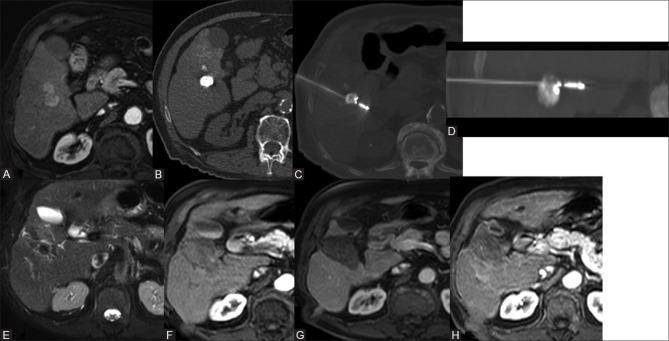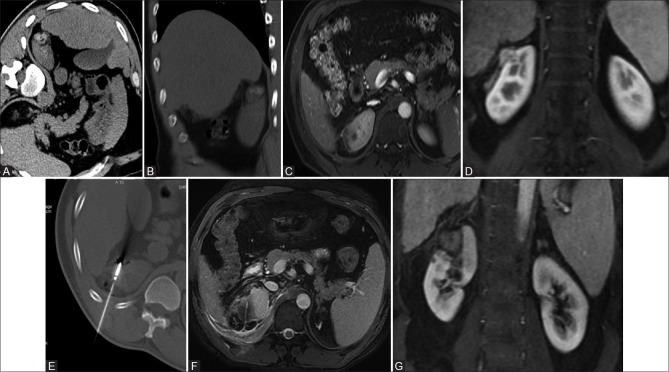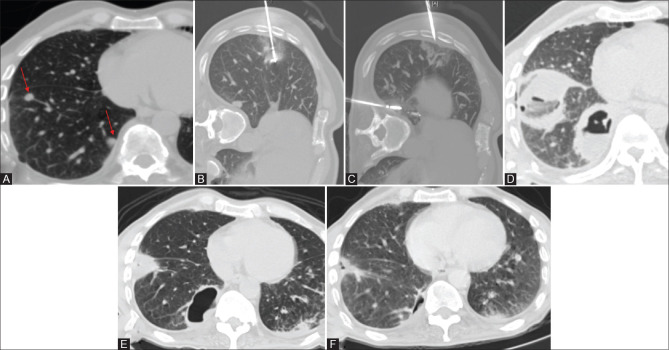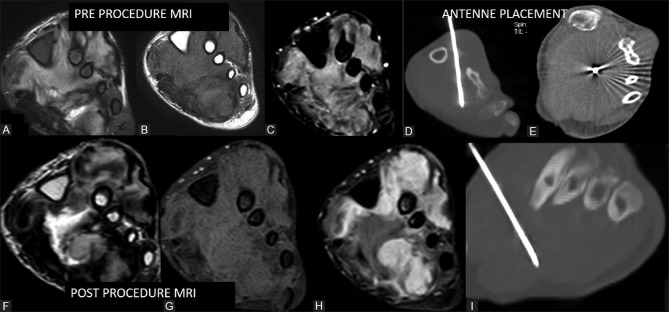Abstract
Minimally invasive techniques such as Image guided thermal ablation are now widely used in the treatment of tumors. Microwave ablation (MWA) is one of the newer modality of thermal ablation and has proven its safety and efficacy in the management of the tumors amenable for ablation for primary and metastatic diseases. It is used in the treatment of primary and secondary liver malignancies, primary and secondary lung malignancies, renal and adrenal tumors and bone metastases. We wanted to share our initial experience with this newer modality. In this article we will describe the mechanism and technique of MWA, comparison done with RFA, advantages and disadvantages of MWA along with pre procedure workup, post procedure follow-up and review of literature.
Keywords: Microwave ablation, Radiofrequency ablation, Technique
Introduction
Tumor ablationis defined as the direct application of chemical or thermal therapies to a tumor to destroy and eradicate tumor to obtain cellular necrosis either by thermal or freezing techniques.[1,2] Image-guided thermal ablation is a minimally invasive technique which has been widely used in the treatment of tumors in various organs. The advantages of image-guided tumor ablation as compared with surgical treatment are faster recovery, reduced morbidity and mortality, lower procedural cost, accurate targeting under ultrasound or CT scan image guidance, and daycare treatments, thus reducing the hospital stay and easily repeatable if residual lesion is present.[3,4]
In India, the different ablative techniques that are used for tumor ablation include chemical ablation using alcohol, energy-based hyperthermic ablation like radiofrequency ablation (RFA), microwave ablation (MWA), cryoablation, or HIFU (high-intensity focused ultrasound) or nonthermal energy-based modality like irreversible electroporation (IRE). While radiofrequency ablation (RFA) remains the most commonly used thermal ablation since close to two decades, microwave ablation (MWA) is being used at few centers since its introduction for the first time in the country in 2015 at our institute. Similar to RFA, MWA is also an energy-based thermal ablative technique and has proven its safety and efficacy in the management of tumor ablation of liver, lung, renal, and adrenal. It is used in the treatment of primary and secondary liver and lung malignancies with both curative and palliative intent. In this article, we will describe the mechanism, technique of MWA, its advantages and disadvantages in comparison to RFA and share our initial experience in ablation of liver, lung, and renal tumors and literature review.
Principle
MWA uses electromagnetic methods for inducing tumor destruction using antenna with frequencies between 900 and 2450 MHz.[5,6,7,8]
MWA works on two theories: i) Dipole theory and ii) Ionic theory.
-
i)
Dipole rotation theory: Water molecules are dipole and cause unequal charge distribution. When electric field is applied, these water molecules rotate and continuously align and oscillate. This rotation of the dipole molecules causes heat generation during MWA and is responsible for most heat generation during microwave. Electromagnetic field as in MWA causes water molecules to agitate in the tissue causing friction and heat leading to cellular death by coagulative necrosis[8,9] [Figure 1].
-
ii)
Ionic polarization theory: In tissue when electromagnetic field is applied, it causes displacement of ions leading collision with other ions, which converts kinetic energy into heat. This is far less important mechanism than dipole rotation.[8,10,11]
Figure 1.
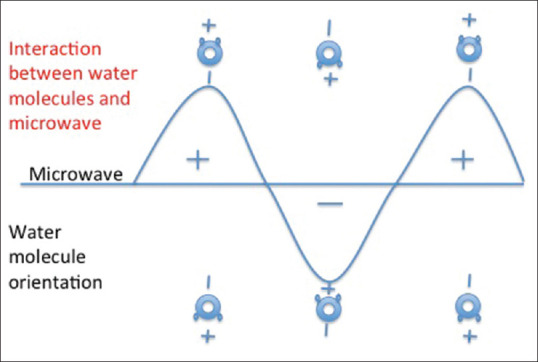
Interaction between water molecules and microwaves
Unlike MWA, radiofrequency ablation uses a frequency of 3 Hz to 300 GHz and electric current is delivered through the electrode producing thermal energy.[3] The electrical circuit gets completed through the grounding pads attached to the thighs or the back and temperature range from 60°C to 100°C resulting in coagulative necrosis.
System Description
Microwave systems equipment is composed of three elements [Figure 2]:
Figure 2 (A-C).
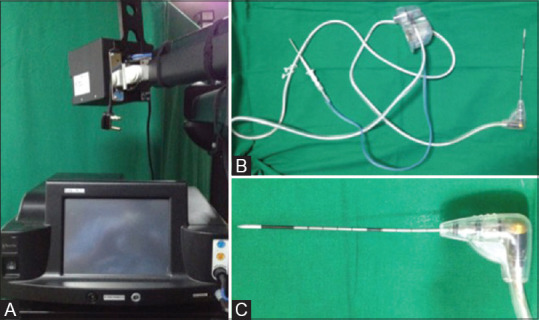
Microwave equipment consisting of (A) microwave generator, (B) flexible coaxial cable, and (C) microwave antenna
-
i)
Microwave generator—Microwaves are generated by a magnetron in the generator
-
ii)
Flexible coaxial cable and
-
iii)
Microwave antenna—An antenna is connected with coaxial cable to the generator and transmits microwaves into the tissue. Antennas can be classified depending on their physical features and radiation properties. The microwave antenna is 14-17-gauge structure which is placed into the tumor [Figure 3]. Total tumor necrosis can be achieved when temperature remains at 54°C for at least 3 min or reaches 60°C instantly.[12]
Figure 3.

Microwave antenna
Procedural Technique
Depending on the site and histopathology, patient would undergo either CECT/PET-CT or CE-MRI as preprocedure test. The blood parameters were optimized as per the guidelines of SIR.[13]
All the ablations were done under general anesthesia with suspended ventilation at the time of applicator placement. The antenna of the microwave was placed under image guidance either under USG or CT scan depending on the site of the lesion. Even in cases where antenna was placed under ultrasound guidance, CT scan was done to confirm the location of the antenna, prior to starting ablation. The antenna is positioned within the lesion and power and time of energy delivery adjusted so that the ablation not only covers the entire lesion but also a centimeter of normal parenchyma all around the lesion (A0 ablation). Adjuvant technique like hydrodissection or pneumodissection was performed to protect nearby structures like bowel, gall bladder, or diaphragm to prevent inadvertent thermal injury. The adequacy of ablation was confirmed by CT scan and overlapping ablations were performed till an adequate A0 ablation zone was obtained. On completion of lesion ablation, tract ablation was performed as the antenna was withdrawn as per manufacturer recommended settings. A post ablation contrast-enhanced CT scan was done to check for the completeness of the tumor ablation and procedural complications if any.
We followed our cases at 6 weeks, 3 months, and 6 months after the procedure with dynamic contrast-enhanced MRI or FDG-PET-CT scan or CECT scan depending on whether the tumors ablated were primary or metastatic lesions.
Microwave ablation occurs due to direct heating of the tissue when the energy is deposited in the tissue delivered antenna. As compared to this, RFA creates heat via resistive heating when electrical current passes through the ionic tissue medium and hence would require an electrically conductive path. The power delivered through charred or desiccated tissues reduces significantly in case of RFA which tends to build up around all electrode resulting in incomplete ablation, while microwave ablation is not affected by this.
Discussion
Microwave ablation is an energy-based thermal ablative technique which causes cellular death by coagulative necrosis via dipole and ionic mechanisms as explained earlier. It is similar to RFA but has its own advantages and disadvantages which have been explained below along with few clinical applications and literature review. MWA can be used percutaneously, laparoscopic or open surgically with either ultrasound, CT or Fluoroscopy guided needle placement.
MWA used electromagnetic field while RFA used electric energy.[5] In RFA, there is heat sink effect when the thermal energy is applied to lesion due to blood flowing to adjacent vessels, which causes ablation to be unpredictable,[14,15] whereas MWA causes homogenous, larger ablation and less heat sink due to the electromagnetic field and rapid heating.[2,16] The advantages of MWA are higher intratumoral temperatures, larger and predictable tumor volumes, faster ablation, optimal heating of cystic masses, less procedural pain, and can use multiple applicators.[17,18,19,20,21] MWA does not require the grounding pads, which saves time and complications like pad burns[1] [Figure 4]. Livraghi et al.[21] in multicentric study said few operators found microwave causes less pain as compared to RFA. However, they also mentioned the level of pain is person dependent, according to the person threshold. Pain is more in case of superficial or para hilar lesions.
Figure 4.
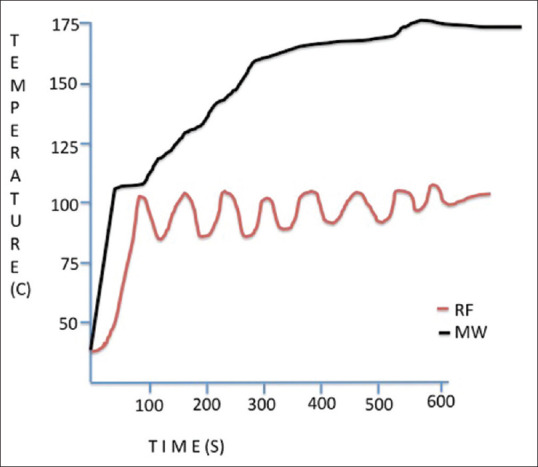
Microwave versus RF temperatures in vivo
Clinical applications in various organs
The “liver” is a large, solid vascular organ with number of large vessels; thus, there is more chance of heat-sink effects. However, microwave overcomes the heat sinks as compared to RFA or other heat-based ablation modalities and less chances of recurrence which is explained earlier in detailed above.[16,22,23,24,25] Microwave energy can produce large and consistent zones of ablation in shorter times as compared with RF ablation, adjacent to hepatic vessels as large as 10 mm with good results.[22,23,24,25,26] Dong et al.[26] in their study of 234 patients who had undergone percutaneous MWA had favorable survival without any severe complications. Lu et al.[27] in his retrospective study of 102 patients compared the treatment of MWA and RFA and found no significant difference in survival or complication rates between the two groups.
We selected the cases of microwave ablation of the liver, which included those which were close to vessels of size 3 mm or more, lesions larger than 3 cm, and those which were close to the surface limiting the use of expandable RFA electrodes [Figures 5–7]. Overall results of local control with RFA or MWA are controversial in HCC. There are some studies with good local control with RFA as in Shibata el al. (89% with MWA and 93% with RFA).[28] Local recurrence is 9% with RFA as opposed to 19% with MWA by Ohmoto et al.[29] and 5.2% with RFA as opposed to 10.9% with MWA by Ding et al.[30] Thus, these studies favour RFA over MWA. Lu et al. in retrospective study showed complete ablation of 95% with MWA and 93% with RFA;[31] this study favors MWA over RFA. However, there is no much difference between these modalities.
Figure 5 (A-D).
45-year-old female, Operated case of with solitary liver metastasis in segment VIII/V on CECT (A). The lesion is surrounded by portal and hepatic veins so MWA was chosen. Antenna (D) was placed beyond the lesion. Post procedure CECT (C) good ablation zone was seen. Follow-up after 3 months was done with CEMR (D) which shows no enhancement in the lesion suggested of complete response
Figure 7 (A-H).
70-year-old male with multiple co-morbidities. CEMR reveals solitary lesion in the segment V/VI of liver showing arterial wash-in and venous wash out (A). Lipiodol TA TACE done, plain CT reveals good Lipiodol deposition (B), MW antenna was placed 1 cm beyond the lesion (C). Post MWA MR was done on follow-up (E-G) which reveals on T2 hypo intensity and no enhancement. 6-month follow-up also reveals no enhancement (H)
Figure 6 (A-C).
3-year-old male child known case of Wilm's tumor with metastatic liver lesions. CECT done (A) which reveals hypodense lesion in segment VII of the liver which was in close proximity to right hepatic vein. The placement of the antenna (B) is beyond the lesion to get the margins. Post procedure CECT (C) reveals complete ablation of the lesion with significant large zone of ablation. This indicates zone of ablation depends on the tissue
The “kidney,” also like liver is a highly vascular solid organ and causes significant heat-sink effects.[32] Since with the advent of cross-sectional imaging, small renal cancers are identified earlier and treated with the development of nephron sparing surgery techniques and ablative therapies, which are now the methods of treatment of T1 renal cell carcinoma.[33] There is a risk of damaging the renal pelvis or ureter during hyperthermic ablation if tumor is large or centrally located, which can cause urinary leak and later stricture formation. These are difficult tumors to treat with RF and microwave ablation.[34] Liang et al.[35] treated 12 patients with renal cell carcinomas with tumors <4 cm in diameter with microwave and found complete ablation in a single session with no residual or recurrent tumor at a median follow-up of 11 months and with exclusion of tumors near renal hilum, bowel, or ureter. Clark et al.[36] demonstrated ablation with microwave in biopsy-proven RCC before undergoing radical nephrectomy and results show that there was no viable tumor remaining after ablation. Yu et al.[37] retrospectively compared the outcomes of MWA in 65 patients with open radical nephrectomy (ORN) in 98 patients. 1-, 3-, and 5-year RCC related survival of MWA and ORN groups was 97.1%, 97.1%, 97.1% and 99.0%, 97.8%, 97.8%, respectively. In all the studies that were conducted till now had no data on the angioembolization prior to MWA for renal tumors >3.0 cm as opposed to conventional chemoembolization in HCC for liver. The most advantage of the microwave over RFA is that MWA takes shorter duration. We performed MWA of renal lesions which were peripherally located and did not encounter any post procedural complications or recurrence after 2-year follow-up [Figure 8].
Figure 8 (A-G).
43-year-old male patient with Hepatitis C incidentally diagnosed solid enhancing lesion in the right kidney. CECT (A and B) reveals exophytic lesion in the upper polar region of the right kidney. On MRI, T2 FAT SAT sequence (C) shows isointense lesion and post-contrast (D) shows mild enhancement. Microwave antenna (E) was placed across the lesion under CT guidance. Post MWA follow-up MRI was done which revealed no residual lesion s/o good response (E and F)
In “lung,” ablative methods have been used for unresectable primary lung tumors for pain palliation or resectable primary lung tumors who are not fit for surgery or secondaries. The limitations of RFA are that aerated lung has low electrical conductivity and poor thermal conduction, thus being less effective; however, this does not affect MW nor does it degrade the volume heating and in fact lower permittivity and conductivity inherent in lung may allow deeper penetration.[38,39] Microwave has the advantage of achieving ablation even in tissues with low conductivity and high impedance of the aerated lung and hence can be used for ablation of lung lesions. Wolf et al.[40] showed MW is safe and effective in lung tumors when they treated 82 lung masses in 50 patients with local control rate of 67% at 1 year [Figure 9]. He also said that the patients who developed cavitation post procedure had better survival of 43%. In our experience of post ablation, most of the patient develops consolidation immediately on the post procedure scan and few of them have developed cavitation which resolved later [Figure 9]. In pulmonary tumors, overall survival at 0.5-, 1-, 2-, 3-, and 5-year rates were 95%, 77%, 55%, 42%, and 34%, respectively, for the RFA group and 92%, 75%, 44%, 40%, and 27%, respectively, for the MWA group in the study done by Shi et al.[41] Jiang et al.[42] in a meta-analysis study showed that local recurrence rate with RFA was 19.8% and with MWA was 10.9%. Overall MWA and RFA are almost comparable with the advantages of MWA described above.
Figure 9 (A-F).
47-year-old male operated case of sigmoid colon. CECT reveals two lung nodules in the right lower lobe (A). Simultaneous MW antennas are placed from the lateral and posterior approach (B and C). 6-week follow-up CECT reveals cavitation formation at the site of ablation (D). 3-month follow-up reveals resolution of the cavitation with cystic changes (E). 6-month follow-up reveals near-complete resolution of cavitation (F)
We have done few cases of fibromatosis with MW but with small zone of ablations. The reason of small ablation zone in fibromatosis is no free ions to conduct the current. Till now no literature has been there of microwave in fibromatosis [Figure 10]. There are few articles of RFA in fibromatosis; Schmitz et al.[43] have described that percutaneous cryoablation is safe and effective in 26 patients of extra abdominal desmoid tumors for local control. Ilaslan et al.[44] described RFA as one of the treatment options in the local control of desmoid tumors. In our experience, RFA works better than MWA in desmoid fibromatosis. After MWA, patient is followed up after 6 to 8 weeks with CEMRI to look for necrosis and solid residual component and if present, another session is planned. After having small ablation zone, we used RFA for fibromatosis. RFA in fibromatosis was done to achieve good range of movement, local control of tumor, and symptom relief. In fibromatosis, no A0 ablation was planned.
Figure 10 (A-I).
19-year-old male with history of surgery done twice and recurrence of swelling. Patient was started on metronomic chemotherapy but had progression of swelling and thus was referred for ablative therapy. Preprocedure MRI reveals soft tissue mass on the plantar aspect encasing metatarsal with iso- to hypo-intense on T2 (A) and shows heterogenous post-contrast enhancement (B and C). Antenna placement done (D, E and I). Small nonenhancing necrotic area is seen post microwave ablation (F-H)
The disadvantages of MWA are delivery of low power, heating of the shaft, long and thin ablation zone, limitation in clinical application in bone and surface lesion, and unpredictable zone of ablation.[11]
We have done approximately 101 cases with microwave till now and had 6 major complications [Table 1] in liver (4 pseudoaneurysm, 2 biliary dilatation, 1 liver abscess) and 5 major complications in lung (3 cavitation, 1 hemothorax, 2 pneumonia) [Table 2].
Table 1.
Comparison of RFA and MWA
| RFA | MWA | |
|---|---|---|
| Mechanism | Electric current | Electromagnetic energy |
| Heating | Nonuniform | Uniform |
| Procedure time | More | Less |
| Intratumoral Temperature | Less | More |
| Ablation zone | Unpredictable | Predictable |
| Heat sink effect | Present | Less susceptible |
| Periprocedure pain | More | Less |
| Lesion treated at one time | Single | Multiple |
| Ablation volume | Small | Large |
| Grounding pad | Present thus can lead to thermal burns | Absent |
Table 2.
Complication of MWA
| Complications in organ | Major | Type of complication and Management |
|---|---|---|
| Liver | 6 | 4 Pseudoaneurysm (Angioembolization) |
| 2 Biliary dilatation (1 Percutaneous biliary drainage and other atrophy of left lobe) | ||
| 1 Abscess (Drainage catheter placement) | ||
| Lung | 5 | 3 cavitation |
| 1 hemothorax | ||
| 2 pneumonia |
Livraghi et al.[21] in a multicentric study showed the complications’ rate of 2.9% in 736 patients with liver lesions using MWA, while another study conducted by the same group in 2003,[45] which was also a multicentric study, showed the complications’ rate of 2.2% using RFA in 2320 patients. Liang et al.[46] also showed complications’ rate of 2.6% in 1136 patients using percutaneous MWA. Wolf et al.[40] showed cavitation in 43% which reduced cancer-specific mortality using MWA. Zheng et al.[47] showed complications in 20.6% using MWA.
Conclusion
The ablative technology plays an important role in local regional therapy of patients who are not fit for surgery. Heat ablative technology like RFA, MWA, laser, and HIFU plays an important role in controlling tumor in various organs; however, RFA and MWA are the most important thermal ablative systems. RFA and MWA differ in the mechanism of action as described in details above but the end result is heat energy converted into coagulative necrosis of tumor cells. Microwave ablation in our experience has good technical success; it reaches high temperature faster so causes uniform and larger ablation zone, less susceptible to heat sink effect in vascular organs like liver and kidney as compared to RFA. MWA also overcomes the disadvantage of low conductivity and high impedance of aerated lung charred tissues which may be encountered during RFA. Due to the higher cost of microwave antenna as compared to RFA electrode and comparable survival results between both, MWA may be opted in select cases where RFA has its limitation.
Financial support and sponsorship
Nil.
Conflicts of interest
There are no conflicts of interest.
References
- 1.Halsted WS. The results of operations for the cure of cancer of the breast performed at the Johns Hopkins hospital from June, 1889, to January, 1894. Ann Surg. 1894;20:497–555. doi: 10.1097/00000658-189407000-00075. [DOI] [PMC free article] [PubMed] [Google Scholar]
- 2.Simon CJ, Dupuy DE, Mayo-Smith WW. Microwave ablation: Principle and applications. Radiographics. 2005;25(Suppl 1):S69–83. doi: 10.1148/rg.25si055501. [DOI] [PubMed] [Google Scholar]
- 3.Goldberg SN, Gazelle GS, Mueller PR. Thermal ablation therapy for focal malignancy: A unified approach to underlying principles, techniques, and diagnostic imaging guidance. AJR Am J Roentgenol. 2000;174:323–31. doi: 10.2214/ajr.174.2.1740323. [DOI] [PubMed] [Google Scholar]
- 4.Dupuy DE, Goldberg SN. Image-guided radiofrequency tumor ablation: Challenges and opportunities—part II. J Vasc Interv Radiol. 2001;12:1135–48. doi: 10.1016/s1051-0443(07)61670-4. [DOI] [PubMed] [Google Scholar]
- 5.Shibata T, Iimuro Y, Yamamoto Y, Maetani Y, Ametani F, Itoh K, et al. Small hepatocellular carcinoma: Comparison of radio-frequency ablation and percutaneous microwave coagulation therapy. Radiology. 2002;223:331–7. doi: 10.1148/radiol.2232010775. [DOI] [PubMed] [Google Scholar]
- 6.Seki T, Tamai T, Nakagawa T, Imamura M, Nishimura A, Yamashiki N, et al. Combination therapy with transcatheter arterial chemoembolization and percutaneous microwave coagulation therapy for hepatocellular carcinoma. Cancer. 2000;89:1245–51. [PubMed] [Google Scholar]
- 7.Lu MD, Chen JW, Xie XY, Liu L, Huang XQ, Liang LJ, et al. Hepatocellular carcinoma: US-guided percutaneous microwave coagulation therapy. Radiology. 2001;221:167–72. doi: 10.1148/radiol.2211001783. [DOI] [PubMed] [Google Scholar]
- 8.Sun Y, Wang Y, Ni X, Gao Y, Shao Q, Liu L, et al. Comparison of ablation zone between 915- and 2,450-MHz cooled-shaft microwave antenna: Results in in vivo porcine livers. AJR Am J Roentgenol. 2009;192:511–4. doi: 10.2214/AJR.07.3828. [DOI] [PubMed] [Google Scholar]
- 9.Tanaka M, Sato M. Microwave heating of water, ice, and saline solution: Molecular dynamic study. J Chem Phys. 2007;126:034509. doi: 10.1063/1.2403870. [DOI] [PubMed] [Google Scholar]
- 10.Skinner MG, Iizuka MN, Kolios MC, Sherar MD. A theoretical comparison of energy sources—microwave, ultrasound and laser—for interstitial thermal therapy. Phys Med Biol. 1998;43:3535–3547. doi: 10.1088/0031-9155/43/12/011. [DOI] [PubMed] [Google Scholar]
- 11.Lubner MG, Brace CL, Ziemlewicz TJ, Hinshaw JL, Lee Jr FT. Microwave ablation of hepatic malignancy. Semin Intervent Radiol. 2013;30:56–66. doi: 10.1055/s-0033-1333654. [DOI] [PMC free article] [PubMed] [Google Scholar]
- 12.Kotewall CN, Cheung TT. Microwave ablation for liver malignancy: A literature review. Clin Surg. 2016;1:1130. [Google Scholar]
- 13.Lu DS, Raman SS, Limanond P, Aziz D, Economou J, Busuttil R, et al. Influence of large peritumoral vessels on outcome of radiofrequency ablation of liver tumors. J Vasc Interv Radiol. 2003;14:1267–74. doi: 10.1097/01.rvi.0000092666.72261.6b. [DOI] [PubMed] [Google Scholar]
- 14.Mulier S, Ni Y, Jamart J, Ruers T, Marchal G, Michel L. Local recurrence after hepatic radiofrequency coagulation: Multivariate meta-analysis and review of contributing factors. Ann Surg. 2005;242:158–71. doi: 10.1097/01.sla.0000171032.99149.fe. [DOI] [PMC free article] [PubMed] [Google Scholar]
- 15.Bhardwaj N, Strickland AD, Ahmad F, Atanesyan L, West K, Lloyd DM. A comparative histological evaluation of the ablations produced by microwave, cryotherapy and radiofrequency in the liver. Pathology. 2009;41:168–72. doi: 10.1080/00313020802579292. [DOI] [PubMed] [Google Scholar]
- 16.Patel IJ, Davidson JC, Nikolic B, Salazar GM, Schwartzberg MS, Walker TG, et al. Consensus guidelines for periprocedural management of coagulation status and hemostasis risk in percutaneous image-guided interventions.for the Standards of practice committee, with Cardiovascular and interventional radiological society of europe (CIRSE) endorsement. J Vasc Interv Radiol. 2012;23:727–36. doi: 10.1016/j.jvir.2012.02.012. [DOI] [PubMed] [Google Scholar]
- 17.Simon CJ, Dupuy DE, Mayo-Smith WW. Microwave ablation: Principles and applications. Radiographics. 2005;25(Suppl 1):S69–83. doi: 10.1148/rg.25si055501. [DOI] [PubMed] [Google Scholar]
- 18.Stauffer PR, Rossetto F, Prakash M, Neuman DG, Lee T. Phantom and animal tissues for modeling the electrical properties of human liver. Int J Hyperthermia. 2003;19:89–101. doi: 10.1080/0265673021000017064. [DOI] [PubMed] [Google Scholar]
- 19.Wright AS, Lee FT Jr, Mahvi DM. Hepatic microwave ablation with multiple antennae results in synergistically larger zones of coagulation necrosis. Ann Surg Oncol. 2003;10:275–83. doi: 10.1245/aso.2003.03.045. [DOI] [PubMed] [Google Scholar]
- 20.Shock SA, Meredith Warner TF, Sampson LA, Winter TC, Mahvi DM, Fine JP, et al. Microwave ablation with loop antenna: In vivo porcine liver model. Radiology. 2004;231:143–9. doi: 10.1148/radiol.2311021342. [DOI] [PubMed] [Google Scholar]
- 21.Livraghi T, Meloni F, Solbiati L, Zanus G Collaborative Italian Group using AMICA system. Complications of microwave ablation for liver tumors: Results of a multicenter study. Cardiovasc Intervent Radiol. 2012;35:868–74. doi: 10.1007/s00270-011-0241-8. [DOI] [PubMed] [Google Scholar]
- 22.Brace CL, Laeseke PF, Sampson LA, Frey TM, van derWeide DW, Lee FT Jr. Microwave ablation with a single small-gauge triaxial antenna: In vivo porcine liver model. Radiology. 2007;242:435–40. doi: 10.1148/radiol.2422051411. [DOI] [PMC free article] [PubMed] [Google Scholar]
- 23.Yang D, Converse MC, Mahvi DM, Webster JG. Measurement and analysis of tissue temperature during microwave liver ablation. IEEE Trans Biomed Eng. 2007;54:150–5. doi: 10.1109/TBME.2006.884647. [DOI] [PubMed] [Google Scholar]
- 24.Yu NC, Raman SS, Kim YJ, Lassman C, Chang X, Lu DS. Microwave liver ablation: Influence of hepatic vein size on heat-sink effect in a porcine model. J Vasc Interv Radiol. 2008;19:1087–92. doi: 10.1016/j.jvir.2008.03.023. [DOI] [PubMed] [Google Scholar]
- 25.Awad MM, Devgan L, Kamel IR, Torbensen M, Choti MA. Microwave ablation in a hepatic porcine model: Correlation of CT and histopathologic findings. HPB (Oxford) 2007;9:357–62. doi: 10.1080/13651820701646222. [DOI] [PMC free article] [PubMed] [Google Scholar]
- 26.Dong B, Liang P, Yu X, Su L, Yu D, Cheng Z, et al. Percutaneous sonographically guided microwave coagulation therapy for hepatocellular carcinoma: Results in 234 patients. AJR Am J Roentgenol. 2003;180:1547–55. doi: 10.2214/ajr.180.6.1801547. [DOI] [PubMed] [Google Scholar]
- 27.Lu MD, Xu HX, Xie XY, Yin XY, Cheng JW, Kuang M, et al. Percutaneous microwave and radiofrequency ablation for hepatocellular carcinoma: A retrospective comparative study. J Gastroenterol. 2005;40:1054–60. doi: 10.1007/s00535-005-1671-3. [DOI] [PubMed] [Google Scholar]
- 28.Shibata T, Iimuro Y, Yamamoto Y, Maetani Y, Ametani F, Itoh K, et al. Small hepatocellular carcinoma: Comparison of radio-frequency ablation and percutaneous microwave coagulation therapy. Radiology. 2002;223:331–7. doi: 10.1148/radiol.2232010775. [DOI] [PubMed] [Google Scholar]
- 29.Ohmoto K, Yoshioka N, Tomiyama Y, Shibata N, Kawase T, Yoshida K, et al. Comparison of therapeutic effects between radiofrequency ablation and percutaneous microwave coagulation therapy for small hepatocellular carcinomas. J Gastroenterol Hepatol. 2009;24:223–7. doi: 10.1111/j.1440-1746.2008.05596.x. [DOI] [PubMed] [Google Scholar]
- 30.Ding J, Jing X, Liu J, Wang Y, Wang F, Wang Y, et al. Comparison of two different thermal techniques for the treatment of hepatocellular carcinoma. Eur J Radiol. 2013;82:1379–84. doi: 10.1016/j.ejrad.2013.04.025. [DOI] [PubMed] [Google Scholar]
- 31.Lu MD, Xu HX, Xie XY, Yin XY, Chen JW, Kuang M, et al. Percutaneous microwave and radiofrequency ablation for hepatocellular carcinoma: A retrospective comparative study. J Gastroenterol. 2005;40:1054–60. doi: 10.1007/s00535-005-1671-3. [DOI] [PubMed] [Google Scholar]
- 32.Williams LR, Leggett RW. Reference values for resting blood flow to organs of man. Clin Phys Physiol Meas. 1989;10:187–217. doi: 10.1088/0143-0815/10/3/001. [DOI] [PubMed] [Google Scholar]
- 33.Campbell SC, Novick AC, Belldegrun A, Blute ML, Chow GK, Derweesh IH, et al. Guideline for management of the clinical T1 renal mass. J Urol. 2009;182:1271–9. doi: 10.1016/j.juro.2009.07.004. [DOI] [PubMed] [Google Scholar]
- 34.Gervais DA, McGovern FJ, Arellano RS, McDougal WS, Mueller PR. Radiofrequency ablation of renal cell carcinoma: Part 1, indications, results, and role in patient management over a 6-year period and ablation of 100 tumors. AJR Am J Roentgenol. 2005;185:64–71. doi: 10.2214/ajr.185.1.01850064. [DOI] [PubMed] [Google Scholar]
- 35.Liang P, Wang Y, Zhang D, Yu X, Gao Y, Ni X. Ultrasound guided percutaneous microwave ablation for small renal cancer: Initial experience. J Urol. 2008;180:844–8. doi: 10.1016/j.juro.2008.05.012. [DOI] [PubMed] [Google Scholar]
- 36.Clark PE, Woodruff RD, Zagoria RJ, Hall MC. Microwave ablation of renal parenchymal tumors before nephrectomy: Phase I study. AJR Am J Roentgenol. 2007;188:1212–4. doi: 10.2214/AJR.05.2190. [DOI] [PubMed] [Google Scholar]
- 37.Yu J, Liang P, Yu XL, Cheng ZG, Han ZY, Zhang X, et al. US-guided percutaneous microwave ablation versus open radical nephrectomy for small renal cell carcinoma: Intermediate-term results. Radiology. 2014;270:880–7. doi: 10.1148/radiol.13130275. [DOI] [PubMed] [Google Scholar]
- 38.Morrison PR, van Sonnenberg E, Shankar S, Godleski J, Silverman SG, Tuncali K, et al. Radiofrequency ablation of thoracic lesions: Part 1, experiments in the normal porcine thorax. AJR Am J Roentgenol. 2005;184:375–80. doi: 10.2214/ajr.184.2.01840375. [DOI] [PubMed] [Google Scholar]
- 39.Van Sonnenberg E, Shankar S, Morrison PR, Nair RT, Silverman SG, Jaklitsch MT, et al. Radiofrequency ablation of thoracic lesions: Part 2, initial clinical experience—technical and multidisciplinary considerations in 30 patients. AJR Am J Roentgenol. 2005;184:381–90. doi: 10.2214/ajr.184.2.01840381. [DOI] [PubMed] [Google Scholar]
- 40.Wolf FJ, Grand DJ, Machan JT, Dipetrillo TA, Mayo-Smith WW, Dupuy DE. Microwave ablation of lung malignancies: Effectiveness, CT findings, and safety in 50 patients. Radiology. 2008;247:871–9. doi: 10.1148/radiol.2473070996. [DOI] [PubMed] [Google Scholar]
- 41.Shi F, Li G, Zhou Z, Xu R, Li W, Zhuang W, et al. Microwave ablation versus radiofrequency ablation for the treatment of pulmonary tumors. Oncotarget. 2017;8:109791–8. doi: 10.18632/oncotarget.22308. [DOI] [PMC free article] [PubMed] [Google Scholar]
- 42.Jiang B, Mcclure MA, Chen T, Chen S. Efficacy and safety of thermal ablation of lung malignancies. A Network meta-analysis. Ann Thorac Med. 2018;13:243–50. doi: 10.4103/atm.ATM_392_17. [DOI] [PMC free article] [PubMed] [Google Scholar]
- 43.Schmitz JJ, Schmit GD, Atwell TD, Callstrom MR, Kurup AN, Weisbrod AJ, et al. Percutaneous cryoablation of extraabdominal desmoid tumors: A 10 year experience. Am J Roentgenol. 2016;207:190–5. doi: 10.2214/AJR.15.14391. [DOI] [PubMed] [Google Scholar]
- 44.Ilaslan H, Schils J, Joyce M, Marks K, Sundaram M. Radiofrequency ablation: Another treatment option for local control of desmoid tumors. Skeletal Radiol. 2010;39:169–73. doi: 10.1007/s00256-009-0807-6. [DOI] [PubMed] [Google Scholar]
- 45.Livraghi T, Solbiati L, Meloni MF, Gazelle GS, Halpern EF, Goldberg SN. Treatment of focal Liver tumors with percutaneous radiofrequency ablation: Complicaions encountered in a multicenter study. Radiology. 2003;226:441–51. doi: 10.1148/radiol.2262012198. [DOI] [PubMed] [Google Scholar]
- 46.Liang P, Wang Y, Yu X, Dong B. Malignant liver tumors: Treatment with percutaneous microwave ablation—complications among cohort of 1136 patients. Radiology. 2009;251:933–40. doi: 10.1148/radiol.2513081740. [DOI] [PubMed] [Google Scholar]
- 47.Zheng A, Wang X, Yang X, Wang W, Huang G, Gai Y, et al. Major complications after lung microwave ablation: A single-center experience on 204 sessions. Ann Thorac Surg. 2014;98:243–8. doi: 10.1016/j.athoracsur.2014.03.008. [DOI] [PubMed] [Google Scholar]




